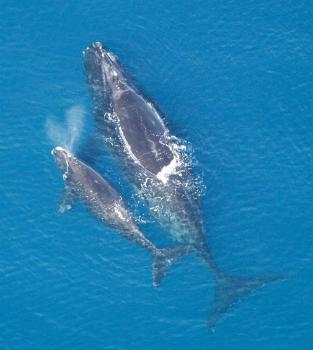Ancient bones from Roman archaeological sites reveal two whale species lost from the Mediterranean Sea
Posted on 11 July 2018

North Atlantic right whale (Eubalaena glacialis) and calf. This species was
nearly extirpated by centuries of whaling and persists only as a small
population off eastern North America. This study found that it entered the
Mediterranean Sea to reproduce. Photo credit: NOAA
The discovery of the whale bones in the ruins of a Roman fish processing factory located at the strait of Gibraltar also hints at the possibility that the Romans may have hunted the whales.
Prior to the study, by an international team of ecologists, archaeologists and geneticists, it was assumed that the Mediterranean Sea was outside of the historical range of the right and gray whale.
Extinction threat
Academics from the Archaeology Department at the University of York used ancient DNA analysis and collagen fingerprinting to identify the bones as belonging to the North Atlantic right whale (Eubalaena glacialis) and the Atlantic gray whale (Eschrichtius robustus).
After centuries of whaling, the right whale currently occurs as a very threatened population off eastern North America and the gray whale has completely disappeared from the North Atlantic and is now restricted to the North Pacific.
Co-author of the study Dr Camilla Speller, from the University of York, said: “These new molecular methods are opening whole new windows into past ecosystems. Whales are often neglected in Archaeological studies, because their bones are frequently too fragmented to be identifiable by their shape.
“Our study shows that these two species were once part of the Mediterranean marine ecosystem and probably used the sheltered basin as a calving ground.
“The findings contribute to the debate on whether, alongside catching large fish such as tuna, the Romans had a form of whaling industry or if perhaps the bones are evidence of opportunistic scavenging from beached whales along the coast line.”
Roman industry
Both species of whale are migratory, and their presence east of Gibraltar is a strong indication that they previously entered the Mediterranean Sea to give birth.
The Gibraltar region was at the centre of a massive fish-processing industry during Roman times, with products exported across the entire Roman Empire. The ruins of hundreds of factories with large salting tanks can still be seen today in the region.

Aerial view of some of the fish-salting tanks (cetaria) in the ancient Roman city of Baelo Claudia, near today’s Tarifa in Spain. The largest circular tank is 3 meters wide. These tanks were used to process large fish,particularly tuna, and the study supports the possibility that they could have also been used to process whales.Credit: D. Bernal-Casasola, University of Cadiz
Lead author of the study Dr Ana Rodrigues, from the French National Centre for Scientific Research, said: “Romans did not have the necessary technology to capture the types of large whales currently found in the Mediterranean, which are high-seas species. But right and gray whales and their calves would have come very close to shore, making them tempting targets for local fishermen.”
It is possible that both species could have been captured using small rowing boats and hand harpoons, methods used by medieval Basque whalers centuries later.
Ancient texts
The knowledge that coastal whales were once present in the Mediterranean also sheds new light on ancient historical sources.
Anne Charpentier, lecturer at the University of Montpellier and co-author in the study, said: “We can finally understand a 1st-Century description by the famous Roman naturalist Pliny the Elder, of killer whales attacking whales and their new-born calves in the Cadiz bay.
“It doesn’t match anything that can be seen there today, but it fits perfectly with the ecology if right and gray whales used to be present.”
The study authors are now calling for historians and archaeologists to re-examine their material in the light of the knowledge that coastal whales where once part of the Mediterranean marine ecosystem.
Dr Rodriguez added: “It seems incredible that we could have lost and then forgotten two large whale species in a region as well-studied as the Mediterranean. It makes you wonder what else we have forgotten”.
Forgotten Mediterranean calving grounds of gray and North Atlantic right whales: evidence from Roman archaeological records is published in the journal Proceedings of the Royal Society of London B.
Explore more news

Poor diets fuelling health crisis in the North, report reveals
Wednesday 23 July 2025

Nightjars at real risk from decreasing genetic diversity, researchers warn
Tuesday 22 July 2025

A ‘millet mystery’ in ancient Japan reveals a complex picture of agricultural adoption, research shows
Monday 21 July 2025

Wednesday's child is not "full of woe," new study finds, debunking popular nursery rhyme
Wednesday 16 July 2025

Optical telescope on York rooftop to advance communication between space and earth
Wednesday 16 July 2025
Media enquiries
About this research
This research was carried out by Dr Camilla Speller from the Department of Archaeology. The study is published in the journal Proceedings of the Royal Society of London B.
The study was an international collaboration between scientists at the universities of York, Montpellier (France), Cadiz (Spain), Oviedo (Spain) and the Centre for Fishery Studies in Asturias, Spain.
Explore our research.
